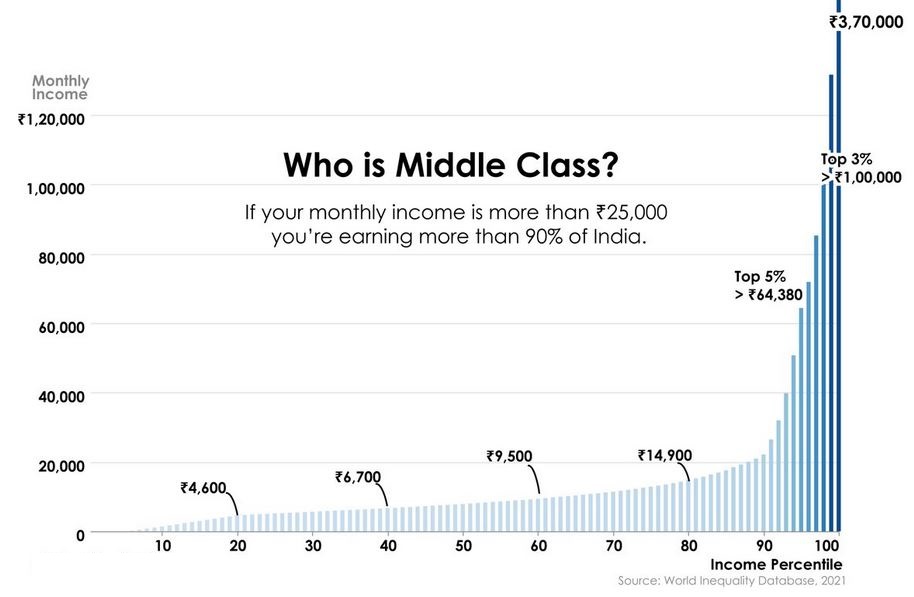Note4Students
From UPSC perspective, the following things are important :
Prelims level: NA
Mains level: Middle class woes in India

Central Idea
- Estimating India’s middle class: This article delves into the estimation of India’s middle class, a crucial indicator of household consumption and the economy’s health.
Key points of discussions
- Lack of clarity in defining the middle class: The absence of a clear definition results in diverse estimations, based on subjective judgments or income ranges and consumption benchmarks.
- Importance of expanding the middle class: Despite the impact of the existing middle class, the focus is shifting towards significant expansion to unleash India’s economic potential.
Understanding a Genuine Middle Class
- Characteristics of a genuine middle class: It entails stable and resilient consumption patterns, enabling them to weather economic downturns without significantly reducing consumption.
- Implications for investors and the economy: A stable and resilient middle-class demand instills investor confidence, leading to job creation and reinforcing the middle class. Surplus income contributes to overall savings.
- Continuous income improvement: A strong foundation for continuous income growth within the middle class drives higher-quality consumption and stimulates diverse and high-quality supply responses.
Features of the Indian Middle Class
- Stable income
- Higher levels of education and skills
- Limited disposable income for discretionary spending
- Homeownership aspirations
- Access to credit and financing
- Affordability of consumer durables and comforts
- Prioritization of healthcare and insurance
- Emphasis on savings and investments
- Associated with upward social mobility
- Value placed on education and success
- Active civic engagement
Estimating India’s Genuine Middle Class

- Discrepancy in popular estimates: Popular estimates tend to overstate the middle class’s size, obscuring the actual extent.
- Concentration within the richest deciles: India’s genuine middle class is primarily concentrated within the richest 10 to 20 percent of households rather than uniformly distributed.
- Concerns about occupation profiles: Instability characterizes the occupation profiles of the richest deciles, with a reliance on small agricultural land and informal non-agricultural occupations.
- Limited upward mobility: Chief wage earners in the richest deciles demonstrate limited potential for upward mobility into higher-skilled occupations.
Issues faced by the Indian Middle Class
- Income Stagnation: Many middle-class individuals in India struggle with stagnant income levels, with limited opportunities for significant wage growth or promotions.
- Rising Cost of Living: The increasing cost of essential goods and services, including housing, education, healthcare, and transportation, often outpaces income growth, putting financial strain on the middle class.
- Inflationary Pressures: Inflation rates impact the purchasing power of the middle class, making it challenging to maintain their standard of living and meet their financial obligations.
- Job Insecurity: Middle-class individuals face concerns about job security, as economic uncertainties and technological advancements lead to changes in job markets and potential layoffs.
- Healthcare Expenses: Rising healthcare costs and limited access to quality healthcare put a significant burden on the middle class, impacting their financial well-being and ability to seek necessary medical care.
Consequences of Limited Middle-Class Expansion

- Economic implications: The limited expansion of the middle class hinders the economy from reaching its fullest potential in terms of consumption, investments, and job creation.
- Inequality concerns: A small middle class contributes to income inequality, as a significant portion of the population remains deprived of upward mobility and economic opportunities.
- Overreliance on the affluent: The concentration of economic power and consumption within the richest deciles may result in skewed market dynamics and limited inclusivity.
Strategies for Expanding the Middle Class
- Enhancing education and skill development: Investing in education and skill-building initiatives to equip individuals with the qualifications needed for higher-skilled occupations.
- Promoting entrepreneurship and small businesses: Creating an enabling environment for entrepreneurial growth, which can generate jobs and foster economic resilience within the middle class.
- Strengthening social safety nets: Developing robust social safety nets to provide support during economic downturns and help individuals bounce back without significant setbacks.
- Addressing informal employment: Implementing policies that promote formalization of employment, providing stability and better benefits for workers.
Way forward
- Strengthen financial literacy: Implement comprehensive programs, accessible resources, and collaborations to improve understanding of personal finance.
- Promote entrepreneurship and innovation: Foster an ecosystem with resources, mentorship, and support for middle-class individuals starting businesses.
- Build social safety nets: Establish comprehensive programs for unemployment benefits, healthcare coverage, and retraining support during economic shocks.
- Foster social dialogue: Create platforms for inclusive discussions, partnerships, and collaborations between policymakers, businesses, and the middle class.
- Prioritize work-life balance: Advocate for family-friendly policies, flexible work arrangements, and support for well-being and productivity.
- Support family-friendly policies: Implement policies for affordable childcare, parental leave, and flexible work arrangements to support work-life balance.
Get an IAS/IPS ranker as your 1: 1 personal mentor for UPSC 2024
Get an IAS/IPS ranker as your 1: 1 personal mentor for UPSC 2024
